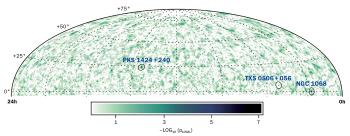
On 12 September, the Japanese government granted seed funding towards the construction of the Hyper-Kamiokande experiment, a next-generation detector for the study of neutrinos. Japan’s Ministry of Education, Culture, Sports, Science and Technology (MEXT) allocated $700,000 within its budget request for the 2019 fiscal year, which will enable progress in preparatory work for construction and efforts to secure international collaboration.
Coinciding with the MEXT announcement, the University of Tokyo pledged to ensure that construction of the Hyper-Kamiokande detector commences in April 2020. According to a statement from university president Makoto Gonokami: “The University of Tokyo has made this decision in recognition of both the project’s importance and value both nationally and internationally. … Seed fundings in the past projects usually lead to full funding in the following year, as was the case for the Super-Kamiokande project.”
Hyper-Kamiokande (Hyper-K) is a water Cherenkov detector centered on a huge underground tank containing 300,000 tonnes of water, with a sensitive volume about a factor of 10 larger than its predecessor Super-Kamiokande (Super-K). Like Super-K, Hyper-K will be located in Kamioka on the west coast of Japan directly in the path of a neutrino beam generated 295 km away at the J-PARC facility in Tokai, allowing it to make high-statistics measurements of neutrino oscillations. Together with a near-detector located close to J-PARC, Super-K formed the “T2K” long-baseline neutrino programme. An order of magnitude bigger than Super-K, Hyper-K will serve as the next far-detector at T2K, with a rich physics portfolio. This ranges from the study of the CP violation in the leptonic sector and measurements of neutrino-mixing parameters, to studies of proton decay, atmospheric neutrinos and neutrinos from astrophysical sources.
It was at Super-K in 1998 that researchers discovered neutrino oscillations, proving that neutrinos are massive and leading to the award of the 2015 Nobel Prize in Physics to Takaaki Kajita of the University of Tokyo and Arthur McDonald of Queen’s University in Canada. The Japanese neutrino programme has progressed steadily since the 1998 discovery (CERN Courier July/August 2016 p29). Hyper-K was discussed as long ago as 2002 and a letter of intent was published in 2011, following the first measurement of the neutrino mixing angle θ13 at T2K, which boosted the expectation of a discovery of leptonic CP violation by Hyper-K. The experiment was placed in Japan’s list of priority projects in 2014 but was not short-listed. The project was proposed again in 2017, this time making the short-list of seven projects to be funded by MEXT. The Hyper-K conceptual design report was published earlier this year (see further reading).
“Hyper-Kamiokande now moves from planning to construction,” said Hyper-K project co-leader Francesca Di Lodovico of Queen Mary University of London, in a statement released by the Kavli Institute for the Physics and Mathematics of the Universe in Japan on behalf of the Hyper-K collaboration. “The collaboration will now work on finalising designs, and is very open to more international partners joining this exciting, far-reaching new experiment.” The Hyper-K proto-collaboration was formed in 2015 and currently comprises around 300 members from 73 institutes in 15 countries. Many European institutes are involved, including the CERN neutrino group, which is already participating in the upgrade of the T2K near detector to serve Hyper-K. To this end, in the summer of
last year a detector called Baby MIND that was designed and built at CERN was shipped to J-PARC (CERN Courier July/August 2017 p12).
“Hyper-K is the next step in the Japanese neutrino adventure,” says Baby MIND spokesperson and Hyper-K collaborator Alain Blondel of the University of Geneva. “This success comes from wise choices and intelligent planning. The increase in the far-detector mass is exciting: demonstration of an asymmetry between neutrinos and antineutrinos was identified as the ‘great discovery’ goal as soon as neutrino oscillations were discovered, although it presents a challenge regarding systematics. And if a proton decay is detected or a supernova strikes, it will be fireworks!”
Further reading
K Abe et al. 2018 arXiv:1805.04163.








